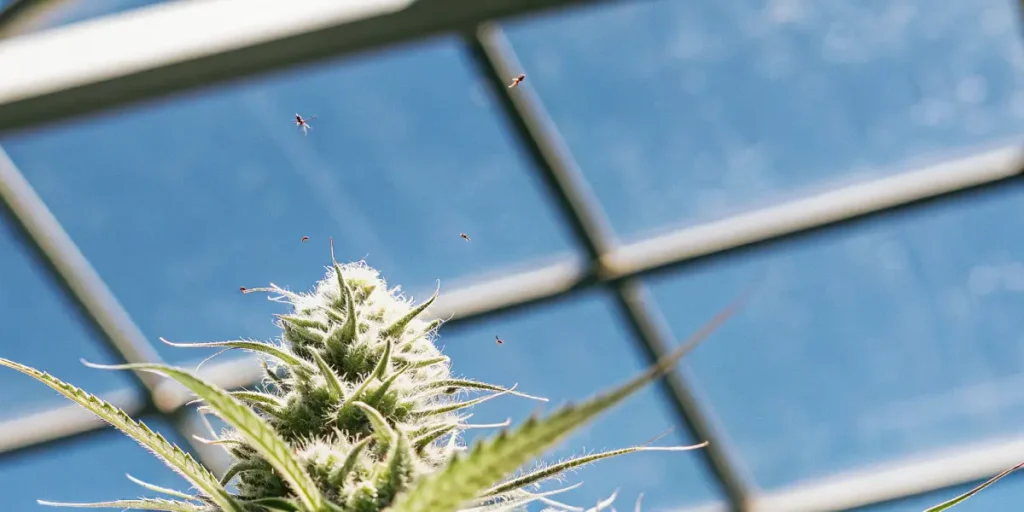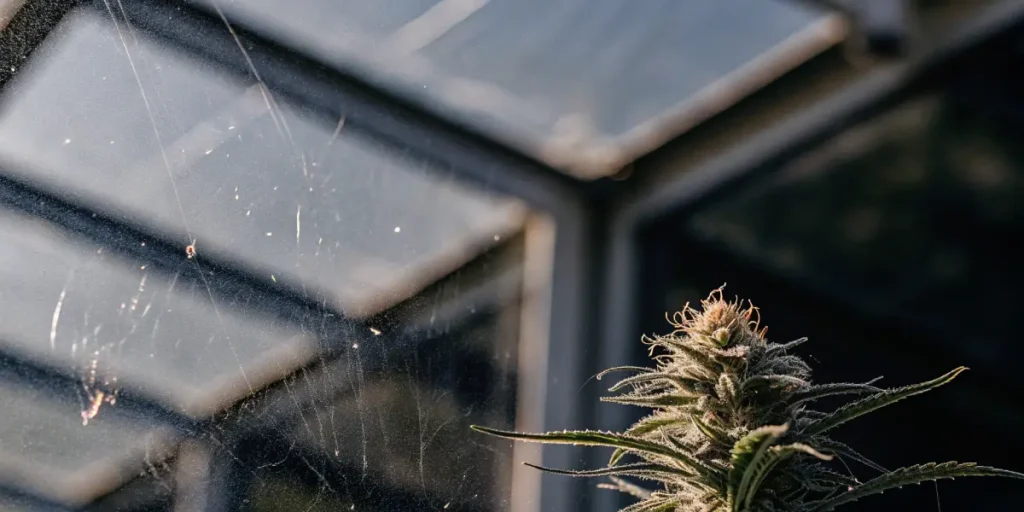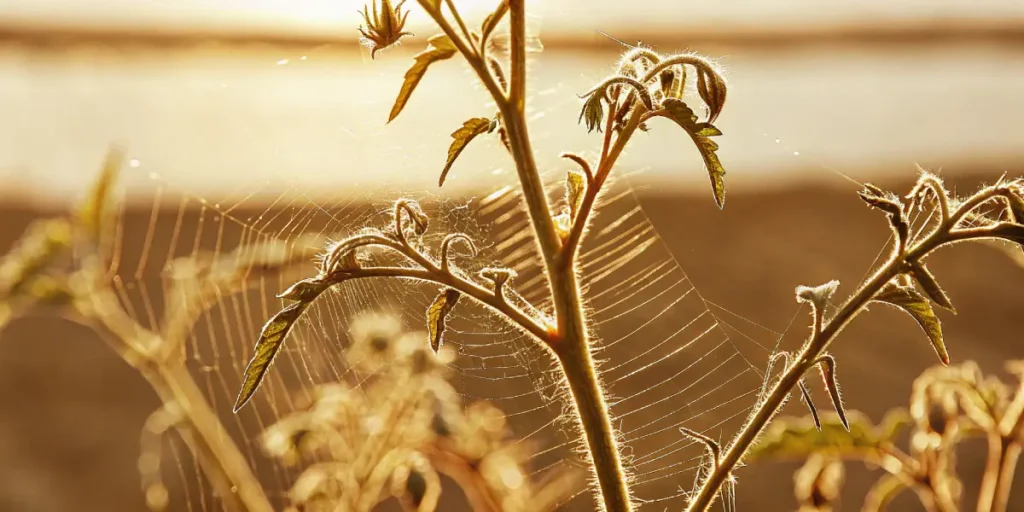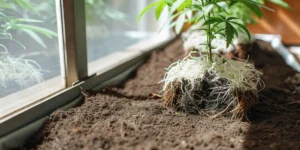Dealing with spider mites on buds at time of harvest can be frustrating. These tiny pests are barely visible to the naked eye, but their damage is unmistakable. They feed on the plant’s nutrients, leaving behind yellow spots and webbing. The buds can suffer greatly, affecting both yield and quality.
It’s crucial to recognize the signs early. Look for discolored leaves and fine webs. Spider mites thrive in warm, dry environments. If you spot them, take action immediately. Waiting too long can devastate your harvest.
Choosing the right strain can make a difference. Some strains are more resistant to pests. Consider trying strains like White Widow, Blue Dream, or Northern Lights from Global Green Genetics. These strains have shown resilience against infestations.
Identifying Spider Mite Infestations
Spider mites are tiny arachnids. Unlike insects, they have eight legs. They’re hard to spot, often requiring a magnifying glass. They cluster under leaves, making detection tricky. Early signs include small yellow or white spots on leaves.
As the infestation grows, you’ll notice webbing on buds. This webbing protects them from predators. The mites feed by sucking sap from leaves. Over time, this weakens the plant, reducing the overall quality of the buds.
Identifying a spider mites infestation during bud harvest can be particularly challenging. The mites’ small size and ability to hide under leaves make them difficult to detect until significant damage is done. Regularly checking your plants can help catch them before they become a major problem.
Another indication of a spider mite infestation is a noticeable decline in plant vigor. Leaves may start to curl, and buds may not develop fully. This can lead to a reduced yield and compromised quality, making early detection and action essential.
Controlling Spider Mites on Cannabis Buds Before Harvest
Once you’ve identified an infestation, act swiftly. Several methods can help control spider mites on cannabis buds before harvest. Natural predators, like ladybugs, can eat the mites. They’re a safe and effective option.
Insecticidal soaps are another option. These are safe for plants but deadly for mites. Apply them directly to affected areas. Ensure you cover both sides of the leaves for maximum effectiveness.
Controlling spider mites on cannabis buds before harvest is critical to ensure a successful yield. Integrating biological controls, such as predatory mites, can effectively reduce the population. These natural enemies of spider mites help maintain a balanced ecosystem within your grow room.
Another method for controlling spider mites on cannabis buds before harvest is to use horticultural oils. These oils suffocate the mites and can be applied without causing harm to the plant. Consistent application can help keep mite populations under control and protect the developing buds.

Managing Spider Mites on Buds at Harvest Time
Managing spider mites on buds at harvest time is crucial. If left unchecked, the mites can ruin your buds. Begin by pruning heavily infested areas. Remove any leaves with significant webbing or discoloration.
Consider using neem oil. It’s a natural pesticide that disrupts the mite’s life cycle. Spray it directly onto the buds, but avoid over-saturating them. You want to target the mites without affecting the buds’ quality.
Managing spider mites on buds at harvest time involves careful monitoring and immediate intervention. Removing infested plant material can prevent further spread. This step is vital in minimizing damage and securing the quality of your harvest.
Another aspect of managing spider mites on buds at harvest time is to ensure proper sanitation. Cleaning your tools and equipment regularly can reduce the chance of transferring mites from one plant to another. This practice is an important part of integrated pest management.
Preventing Spider Mites on Buds During Harvest
Prevention is always better than cure. To prevent spider mites on buds during harvest, maintain optimal growing conditions. Mites hate humidity, so consider raising the moisture levels slightly. However, be cautious not to create an environment prone to mold.
Regular inspections are key. Check your plants daily, especially during the flowering phase. Early detection can prevent a full-blown infestation. If you spot even one mite, take immediate action.
Preventing spider mites on buds during harvest requires a proactive approach. Implementing a regular maintenance schedule that includes cleaning and organizing your grow space can significantly reduce the risk of infestation. By eliminating potential hiding spots, you make it less hospitable for mites.
In addition to environmental controls, using resistant plant strains can be an effective strategy for preventing spider mites on buds during harvest. Selecting strains with a proven track record of resilience against pests is a wise investment for growers concerned about pest management.
- Maintain humidity levels to deter mites.
- Introduce natural predators to control mite populations.
- Use insecticidal soaps for safe and targeted treatment.
- Regularly inspect plants to catch infestations early.
- Clean growing areas frequently to prevent mite habitats.
Dealing with Spider Mites on Marijuana Buds at Harvest
Dealing with spider mites on marijuana buds at harvest requires vigilance. If you’ve struggled with mites in the past, consider strains resistant to pests. Blue Dream from Global Green Genetics is a fantastic choice. It’s known for its resilience and high yield.
If you’re already at harvest time, consider a water wash. Gently rinse your buds under cool water. This can remove mites and their webs. Ensure you dry the buds thoroughly afterward to prevent mold.
One of the key aspects of dealing with spider mites on marijuana buds at harvest is to remain calm and act methodically. Start by isolating affected plants to prevent the mites from spreading. This containment strategy can save the rest of your crop.
Post-harvest, it’s important to store your buds properly. Ensure they are kept in a controlled environment to avoid mold or further mite issues. Proper storage can preserve the quality and integrity of your buds, even if they were exposed to mites during harvest.
Recommended Cannabis Strains
White Widow from Global Green Genetics is a classic choice for growers. It’s known for its pest resistance and potent effects. Its dense buds are less appealing to mites, making it a top pick for many.
Northern Lights is another strain worth considering. It’s renowned for its resilience and ease of growth. This strain is ideal for both beginners and seasoned growers facing mite issues.
Recommended cannabis strains like Blue Dream, White Widow, and Northern Lights are not only famous for their resistance but also their remarkable effects. These strains provide an excellent balance of yield and quality, making them favored among growers.
When selecting cannabis strains, consider your specific growing conditions and pest challenges. Resistant strains can reduce the need for chemical interventions and promote a more organic growing experience, aligning with sustainable cultivation practices.

FAQs
What are the first signs of a spider mite infestation?
The earliest signs of a spider mite infestation include tiny yellow or white spots on the leaves. This is where the mites have fed on the plant’s sap. If left untreated, these spots will expand, and the leaves might start to curl or wilt.
As the infestation progresses, you may also notice fine webbing on the buds and leaves. This webbing can protect the mites from predators and environmental factors. Catching these signs early is key to controlling the spread.
Recognizing the first signs of a spider mites infestation during bud harvest involves paying close attention to your plants’ overall health. Drooping leaves and lack of vigor can be an early indicator that something is amiss.
In addition to visual signs, tactile inspection can be helpful. Running your fingers over the leaves to feel for any rough textures or webs can provide clues that a spider mite problem may be developing.
How can I prevent spider mites during the harvest window?
Preventing spider mites during the harvest window involves maintaining consistent growing conditions. Ensure your grow room is clean and free from potential mite habitats. Regular cleaning and removing dead plant material can significantly reduce the risk.
Introduce beneficial insects such as ladybugs or predatory mites into your grow room. These natural predators can help keep mite populations in check, offering a chemical-free solution to prevention.
Maintaining a robust prevention strategy during the harvest window also means monitoring environmental factors such as temperature and humidity. Keeping these elements within optimal ranges can deter spider mite infestations.
Regularly rotating your plants can also help in preventing spider mites during the harvest window. By changing their position, you reduce the chances of mites settling and establishing colonies undisturbed.
Are there any natural remedies for spider mites?
Yes, there are several natural remedies for spider mites. Neem oil is a popular choice. It’s safe for plants and disrupts the mites’ reproductive cycle. Simply spray it on the affected areas, ensuring you reach the undersides of the leaves.
Another option is essential oils. Oil from rosemary or peppermint can deter mites. Mix a few drops with water and apply it to the plants. This can act as both a preventative measure and a treatment.
In addition to neem oil and essential oils, diatomaceous earth is another natural remedy for spider mites. This powder can be dusted on plants to create a barrier that dehydrates and kills mites upon contact.
Garlic sprays can also be effective. The strong smell and natural compounds in garlic can repel spider mites, making it a simple and cost-effective solution for organic growers.
What should I do if I find mites during harvest?
If you find mites during harvest, act quickly to minimize damage. Start by washing the buds gently with water to remove mites and webs. Be sure to dry them thoroughly to prevent mold growth.
Inspect the buds closely post-wash. If mites persist, consider using a mild alcohol solution as a last resort. While effective, it may alter the final taste and aroma of the buds, so use it sparingly.
Finding mites during harvest can be alarming, but staying calm and methodical is important. After washing, consider using a vacuum to gently remove any remaining mites from the buds. This can be a non-invasive way to deal with the pests.
Post-harvest, focus on drying and curing your buds properly. This process can help eliminate any remaining mites by depriving them of the moist environment they need to survive.
Which cannabis strains are most resistant to spider mites?
Some cannabis strains are naturally more resistant to spider mites. White Widow and Northern Lights, available from Global Green Genetics, are known for their resilience. They have dense buds that are less attractive to mites.
Blue Dream is another strain that offers good resistance. It’s popular for its robust growth and high yield. Opting for resistant strains can reduce the likelihood of mite infestations, ensuring a healthier, more productive harvest.
When selecting strains for resistance to spider mites, consider their growth habits. Strains with dense foliage and resilient stems can better withstand pest pressures, providing an advantage during challenging growing conditions.
Beyond pest resistance, evaluating the overall climate suitability of each strain can lead to better outcomes. Choosing strains that thrive in your specific environment can minimize stress on the plants and make them less susceptible to mite invasions.





